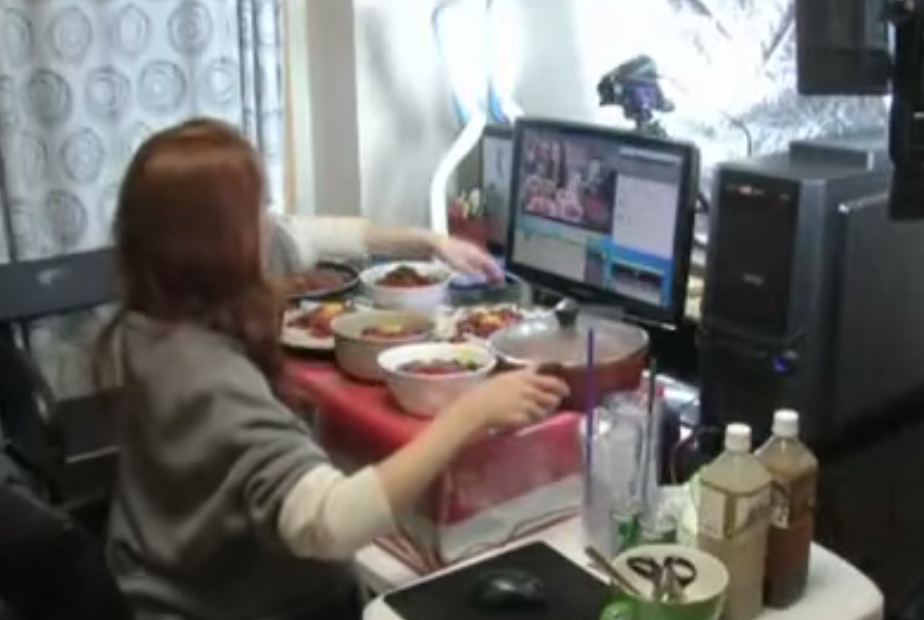But It’s Better Than Eating Alone

Deciding what to eat for dinner is often a chore in and of itself — perhaps it’s the curse of too many choices. And the more people you involve, it often becomes more and more difficult to figure out what’s on the night’s menu. But in South Korea, some people have solved the problem — and then some — by taking it to the extreme.

The animated image above (via Huffington Post) is of a woman named Park Seo-yoon, better known as “The Diva.” You’ll note immediately a few things that aren’t like most dining experiences. First, Park has a massive amount of food in front of her — enough for a sizable dinner party. And yet, there’s no one else sitting at the table. But she’s not quite alone, either; she’s showing some of the food to someone. So, who is she eating with?
A screenshot from the video that the image above comes from (available here) is below. It’ll help us see a lot more of the story:

Park is eating dinner with a computer — and the “guest” that she’s gesturing toward is a camera mounted on top of the monitor. That’s because she’s not just eating dinner. She’s one of a few thousand South Koreans who participates in a cultural phenomenon called “muk-bang,” which literally translates to “eating broadcast.” Wikipedia describes it as “an online broadcast in which a host eats large quantities of food while interacting with their audience,” and currently a few thousand Koreans are broadcasters (and tens if not hundreds of thousands more collectively watch).
And Park’s a pro at it. Literally.
Park and many of her muk-bang counterparts broadcast their dinner through a YouTube-like service called AfreecaTV. The popularity of the muk-bang crowd has given AfreecaTV plenty of incentive to better understand the culture of the meal-watching community, and they’re quick to offer an explanation for it — per NPR, the streaming service attributes the popularity of the oddity to “the growth of Koreans living alone” (25% of households are single-person) which in turn gives “a sense of community in coming together at a dinner table, even if it’s only virtually.”
As a result, Park has become a niche star by eating an unfathomable amount of food for a pretty large audience. Per CNN, Park “easily polishes off four large pizzas or three kilograms (6 lb) of beef in one sitting, albeit over the span of several hours.” And in her case, at least, the broadcast reaches “several thousand” people over that span.
Due to her popularity, Park has made online gluttony her full-time career. TIME explains:
The Diva’s show is part cooking program, part virtual community. Fans tune in to see what she cooks (it varies, but it is always a lot) and how she eats it (with relish). They also send recipes, and ask her questions. (‘How do you eat so much?’) As a sign of appreciation, they send “balloons,” a digital currency that can be converted to cash. She says she now makes about $9000 per month.
That comes to more than $100,000 a year, but that’s her gross (pun not intended) amount; she spends about $3,000 per month on food for the show, so the take-home pay is considerably less. (On the other hand, it’s not like she needs to worry about buying lunch.)
Park is an outlier — most of the thousands of other muk-bang-ers are not able to cover such extravagant costs, let alone quit their day jobs. But for AfreecaTV, it’s a big winner — five percent of its traffic, if not more, is from people watching other people eat dinner.
And you can join them. If you’d like to watch some muk-bang broadcasts on AfreecaTV, you can do so here.
Bonus fact: Muk-bang may be seeing some competition as in recent months, a new “watching others eat online” phenomenon has hit Korea — one involving the ne plus ultra of Internet celebrities: cats. As the AP reported, a kind fan of felines left a meal out for a stray, and the stray learned to come back the next day in search for more. The man kept feeding the cat and set up a web cam to monitor the location, and shortly thereafter, thousands of others began watching, too — with the broadcast now reaching more than 100,000 viewers per month.
From the Archives: Fandemonium: South Korea and the mythical danger of fans.
Take the Quiz: Five U.S. states are geographically larger than South Korea but smaller than North Korea. Name them.
Related: “The Birth of Korean Cool: How One Nation Is Conquering the World Through Pop Culture” by Euny Hong. Probably more about “Gangham Style” than muk-bang, though.
